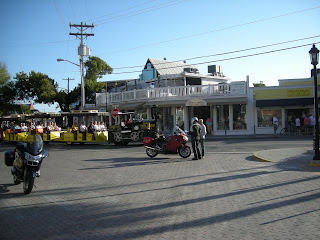We visited the grounds of the Keys Art Museum, as well as Fort Zachary. We took a tour of downtown and the port.
Key West is known for it's free roaming chickens and six toed cats from the Hemingway Museum. They are prevalent throughout the island.
Here are some pictures from our trip, as well as a bit of historical backgound of the area and their very unique environment.













The Origin of the Key West Gypsy Chicken
Though it is thought that these birds have been in Key West for over 175 years, their numbers certainly grew in the 1950s, when thousands of Cubans fled the Revolution and came to Key West to support a booming cigar industry. These Cubans brought their chickens with them. The birds were used for meat and eggs, but the roosters were especially prized for their beauty and prowess for cockfighting. Over time, many birds escaped their enclosures, or were "released" by owners no longer interested in maintaining chickens once eggs and poultry became readily available in local markets. With few predators on the island (except hawks and feral cats) the "wild" chickens thrived on a diet of native insects and lizards. Several generations later, these birds still roam freely throughout the island.


The Ernest Hemingway Home and Museum is home to approximately sixty cats. Normal cats have five front toes and four back toes. About half of the cats at the museum are polydactyl, which means they have extra toes. Most cats have extra toes on their front feet and sometimes on their back feet as well. Sometimes it looks as if they are wearing mittens because they appear to have a thumb on their paw.
Ernest Hemingway was given a six-toed cat by a ship's captain and some of the cats who live on the museum grounds are descendants of that original cat. Key West is a small island and it is possible that many of the cats on the island are related. Our cats are not a particular breed, but appear to be a combination of various breeds-sort of "Heinz 57" if you will. They are all shapes, sizes, colors and personalities.
During the shipping days, and before the days of pesticides, cats were kept to catch rats and mice. The weather is mild here and cats can live comfortably outdoors all year around; they are also quite prolific so they are numerous. There are local residents who feed many stray cats and there is a profusion of restaurants and guest houses where the cats can panhandle for hand-outs.


FORT ZACHARY TAYLOR
Construction of the fort began in 1845, shortly after Florida became a state. In 1850, the fort was named after U.S. President Zachary Taylor, who died in office earlier that year. Throughout the 1850s, construction on Fort Taylor was slow. Yellow fever, shortages of material and men, remoteness and hurricanes had slowed down progress.
When the Civil War broke out in 1861, Capt. John Brannon occupied the fort, placing it in Union hands. Key West was an important outpost for the Union because numerous blockade-running ships were detained at Key West harbor and guarded by Fort Taylor's cannons. The 10-inch Rodman and Columbiad cannons at the fort had a range of three miles. This was an impressive deterrent to the Confederate navy, preventing them from attempting to take the fort or the island of Key West. Proving to be a severe loss for the South, Fort Taylor remained in Union hands throughout the Civil War. By the time the three-story fort was finally finished in 1866 (21 years after it was begun), there were many impressive features included. Items such as sanitary facilities flushed by the tide and a desalination plant which produced drinking water from the sea were available as early as 1861. A total of 198 guns and a large supply of ammunition were on hand to secure the fort.
